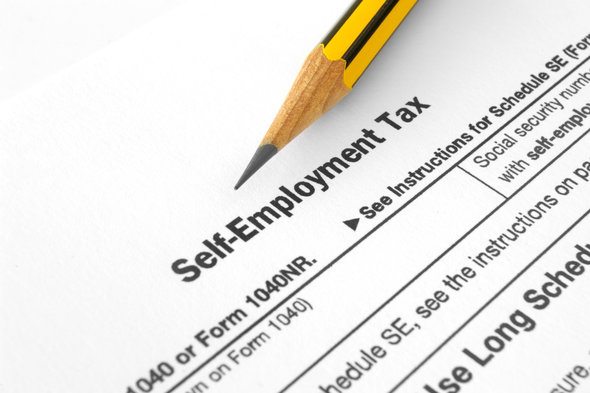As an employee, you may have noticed that your paycheck never matches your full salary. This is because your employer has to withhold certain payroll taxes. You might think that you don’t have to worry about those payroll taxes if you work for yourself, but that’s not the case: you still have to pay a 15.3% self-employment tax. Below, we’ll explore this tax and why you have to pay it.
A financial advisor can help with this or other tax planning issues.
What Is the Self-Employment Tax?
In 1935, the federal government passed the Federal Insurance Contribution Act (FICA), which established taxes to help fund Social Security and Medicare. The FICA tax is 15.3% of gross earnings. The tax is paid by employers and employees, who split the burden by each paying half. Employers pay 7.65% and their employees pay 7.65%.
To ensure that self-employed individuals still contribute toward Social Security and Medicare, the federal government passed the Self-Employed Contributions Act (SECA) in 1954. SECA established that self-employed individuals would be responsible for paying the whole 15.3% FICA. This tax paid by self-employed individuals is known as the SECA, or more simply, the self-employment tax.
Self-Employment Tax Calculation
The total self-employment tax remains 15.3% and is made up of two components. The first is a 12.4% Social Security tax, which applies only up to an annual earnings cap. This cap is adjusted each year for inflation and limits how much of your net self-employment income is subject to Social Security tax. In 2026, individual earnings above the annual Social Security wage base of $184,500 are not subject to the 12.4% portion of the tax.Any net earnings above the cap are excluded from Social Security taxation.
The second component of self-employment tax funds Medicare and is assessed at a rate of 2.9%. Unlike the Social Security portion, the Medicare tax applies to all net self-employment earnings, with no income cap. If you earn $200,000 from self-employment, the full amount is subject to the 2.9% Medicare tax.
In addition, the 0.9% Medicare surtax introduced under the Affordable Care Act continues to apply in 2026 once income exceeds certain thresholds. The surtax applies to income above $200,000 for single filers and heads of household, $250,000 for married couples filing jointly and $125,000 for married couples filing separately. Income above these thresholds is subject to both the 2.9% Medicare tax and the additional 0.9% surtax.
Self-Employment Tax: Who Needs to Pay
As a rule, you need to pay self-employment tax if your net earnings from self-employment are at least $400 during the tax year. This includes individuals who have their own businesses, as well as independent contractors and freelancers. You do not need to pay self-employment tax on income that you earn from an employer if the employer withheld payroll taxes.
Other situations may require you to pay self-employment tax. For one, you still need to pay even if you are a U.S. citizen employed by a foreign government. You must also pay self-employment taxes if you earn more than $108.28 as an employee of a church. If you earn untaxed income in these situations and are unsure whether it’s subject to self-employment tax, it’s best to visit the IRS website or speak with a tax professional.
To review, if you work a full-time job that has payroll taxes deducted but then you earn $1,000 through freelance work, you have to pay self-employment tax on the net earnings from that $1,000 (unless the net is under $400).
Additionally, self-employment tax applies no matter how old you are. If you meet the above requirements and are already receiving Medicare and Social Security benefits, you will still have to pay the tax.
What Are Net Earnings?
The 15.3% tax seems high, but the good news is that you only pay self-employment tax on net earnings. This means that you can first subtract any deductions, such as business expenses, from your gross earnings.
One available deduction is half of the Social Security and Medicare taxes. That’s right, the IRS considers the employer portion of the self-employment tax (7.65%) as a deductible expense. Only 92.35% of your net earnings (gross earnings minus any deductions) are subject to self-employment tax. There are several other tax deductions that self-employed individuals can claim to reduce their taxable earnings, like if you use your home for business.
Let’s say you earn $1,500 from a freelance job and claim $500 in deductions. You would then multiply the net $1,000 ($1,500 minus $500) by 92.35% to determine your taxable earnings. In this example, only $923.50 ($1,000 multiplied by 92.35%) is subject to self-employment tax.
Self-Employment Tax Filing
When filing your annual return, use Schedule C of Form 1040 to calculate your net self-employment income. If your business expenses come out to $5,000 or less, you may be able to file Schedule C-EZ instead of Schedule C.
The Schedule C or Schedule C-EZ will give you your calculated income or loss. This number will then be used on Schedule SE (Form 1040), Self-Employment Tax to calculate how much self-employment tax you should have paid throughout the year.
If you file a joint return with another self-employed person, you must calculate your self-employment taxes separately. The SECA does not allow joint filers to merge their incomes. Again, you will want to check IRS instructions or seek professional financial help to ensure you file your taxes correctly.
In addition to filing an annual tax return, you generally have to make quarterly estimated tax payments if you are self-employed. Estimated tax is used for the self-employed since there is no employer to withhold the taxes. To file these quarterly payments, you use Form 1040-ES, Estimated Tax for Individuals. You will need your annual tax return from the previous year to correctly fill out this form. Filling out the form’s worksheet will determine whether you need to file quarterly estimated tax.
To make your quarterly payments, you can use the Electronic Federal Tax Payment System or mail in the payment vouchers included with Form 1040-ES. For tax year 2026, the first installment of estimated taxes is due April 15, 2027, and the fourth and final installment is due January 15, 2028.
| Tax Year | First Payment | Second Payment | Third Payment | Fourth Payment |
|---|---|---|---|---|
| 2026 | April 15, 2027 | June 15, 2027 | Sept. 15, 2027 | Jan. 15, 2028 |
| 2027 | April 15, 2028 | June 15, 2028 | Sept. 15, 2028 | Jan. 15, 2029 |
If the due date for making an estimated tax payment is a Saturday, Sunday or a legal holiday, the payment will be considered on time if it’s made by the next day that’s not a Saturday, Sunday or holiday.
How Self-Employment Tax Affects Cash Flow and Planning
Self-employment tax changes how income flows throughout the year. Unlike employees, you don’t have taxes withheld automatically from each paycheck, which means more cash stays in your hands. At the same time, that money isn’t fully yours to spend, since part of it must be set aside for Social Security, Medicare and income taxes. This dynamic makes budgeting more complex and increases the risk of falling short at tax time if you don’t plan ahead.
Quarterly estimated tax payments are a direct result of this structure. Instead of settling up once a year, self-employed workers generally pay taxes four times annually. These payments require estimating income in advance, which can be challenging when earnings fluctuate. Missing or underpaying estimates can lead to tax penalties and interest, even if you ultimately pay the full amount when filing your return.
Self-employment tax also affects how deductions and business decisions feel in real terms. Because the tax applies only to net earnings, expenses such as equipment, software, mileage or home office costs reduce not just income tax, but also the self-employment tax itself. This makes accurate recordkeeping and expense tracking more than an administrative task—they directly influence how much tax you owe.
Over time, the impact of self-employment tax extends beyond annual filing. It influences retirement contributions, savings rates and how aggressively you need to plan for future obligations. Since Social Security benefits are tied to reported earnings, consistently managing net income affects both current tax liability and long-term benefits. Seeing self-employment tax as part of an ongoing financial system, rather than a once-a-year bill, can make it easier to plan around.
Bottom Line

Self-employment tax ensures that self-employed individuals make the same contribution and receive the same value of benefits as salaried workers. Don’t forget that without an employer, you will have to do a lot of the tax math to do yourself. If you find yourself overwhelmed or confused by the forms and regulations, you may benefit from speaking to a financial advisor.
Tax Tips
- A financial advisor with tax expertise can also help you optimize your tax strategy for your financial goals and needs. Finding a financial advisor doesn’t have to be hard. SmartAsset’s free tool matches you with vetted financial advisors who serve your area, and you can have a free introductory call with your advisor matches to decide which one you feel is right for you. If you’re ready to find an advisor who can help you achieve your financial goals, get started now.
- SmartAsset’s income tax calculator can be a help if you have a traditional job and want to know what your bill to Uncle Sam will be.
- A financial advisor who specializes in tax planning can help lower your 1099 income taxes by harvesting your losses. This means that you will be able to use your investment losses to reduce taxes on 1099 income.
Photo credit: ©iStock.com/i_frontier, ©iStock.com/Geber86, ©iStock.com/xavierarnau

